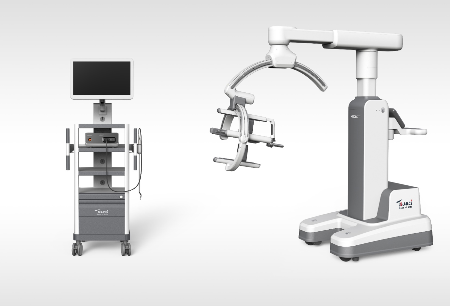Nanchang, Jiangxi Province - On March 14, the clinical trial enrollment of Toumai® single-arm laparoscopic surgical robot (hereinafter referred to as "Toumai® Single-arm") was officially initiated in the First Affiliated Hospital of Nanchang University (hereinafter referred to as the "First Affiliated Hospital of NCU"). On the day of the launch, two urologic surgeries were performed, namely, Toumai® single-arm robot-assisted adrenal pheochromocytoma resection by retroperitoneal single-site laparoscopic approach and Toumai® single-arm robot-assisted transumbilical single-site laparoscopic resection of duplex kidney and duplicated ureter. Both cases were performed by Prof. Gongxian Wang's team, including Prof. Gongxian Wang, Director Cheng Zhang and Dr. Wei Huang of the Department of Urology in the First Affiliated Hospital of NCU.
The first patient was a 49-year-old female, who was found to have a right adrenal mass due to hypertension one month ago. On admission, the CT plain scan and enhanced scan of the abdomen showed a nodule in the right adrenal area, the size of which was about 3.5*2cm.
The second patient, a 25-year-old female, was found to have left duplex kidney for more than 20 years, and recently came to the hospital for examination with self-complaint of back pain. On admission, the CT plain scan and enhanced scan of the lower abdomen + time-lapse imaging showed the duplicitas of renal pelvis and ureter of the left kidney, as well as dilation and hydrops of the duplicated pyelonecalyces and ureter.
For female patients, the surgical effect and quality are essential; however, the aesthetic effect of surgery also matters. Compared with the large incision in traditional open surgery, as well as the multiple incisions in traditional laparoscopic and multi-arm robotic surgery, how to make the surgery less traumatic, less painful, and the scars more hidden is the core demand of patients in this surgery. Prof. Gongxian Wang's team fully considered the needs of patients, and combined with the instrument characteristics of single-arm robot with only one operating port and only adding auxiliary ports when necessary, decided to use Toumai® single-arm surgical robot for this surgery.
The first patient had an adrenal pheochromocytoma located in the retroperitoneal space and she was overweight. After comprehensive evaluation, Prof. Gongxian Wang's team decided to perform adrenal pheochromocytoma resection by retroperitoneal single-site laparoscopic approach. Retroperitoneal approach surgery is widely used in the field of urology. Compared with the transabdominal approach, the retroperitoneal approach does not need to separate and free abdominal organs. For obese patients, the retroperitoneal approach can reduce the damage of the abdominal organs, thus shortening the operation time and the occurrence of intestinal complications. During the surgery, the extraperitoneal fat on the right side was removed, the adrenal tumor was isolated and exposed according to the classic three-dimensional anatomy, and then the adrenal tumor was resected by sequential clamp. Prof. Gongxian Wang's thorough surgical plan, combined with the integrated high-definition field of vision, rotatable surgical instruments and intuitive motion control of the Toumai® single-arm robot, made the surgery smooth, efficient and successful.
For the second patient with duplex kidney, according to the patient's identity characteristics (unmarried and childless), body type characteristics (low body weight) and the location of duplex kidney, Prof. Gongxian Wang's team decided to perform transumbilical single-site laparoscopic resection of the duplex kidney and duplicated ureter, aiming to achieve the best postoperative cosmetic effects under the premise of ensuring the surgical effect. The robot operating port was arranged around the stomach, making the surgical incision more hidden and the surgical scar smaller. With the help of the high-definition immersive 3D field-of-view provided by the Toumai® single-arm robot, Prof. Gongxian Wang accurately identified and isolated the anatomical structure of the dupliex kidney and the position relationship of normal kidney tissue, and isolated and removed the duplex kidney, pelvis and ureter tissue. Prof. Gongxian Wang was skillful in operating and the Toumai® single-arm serpentine surgical instrument followed the surgeon's hand movements precisely, thus the surgery was completed successfully.









 Hu ICP Bei No. 20013662 HGWA Bei No. 31011502015178
Hu ICP Bei No. 20013662 HGWA Bei No. 31011502015178 " are registered trademarks of Shanghai MicroPort Medical (Group) Co., Ltd.” . They have been authorized to be used by Shanghai Microport Medbot (Group) Co., Ltd., and no other party shall use such trademarks without prior written permission thereof.
" are registered trademarks of Shanghai MicroPort Medical (Group) Co., Ltd.” . They have been authorized to be used by Shanghai Microport Medbot (Group) Co., Ltd., and no other party shall use such trademarks without prior written permission thereof.
